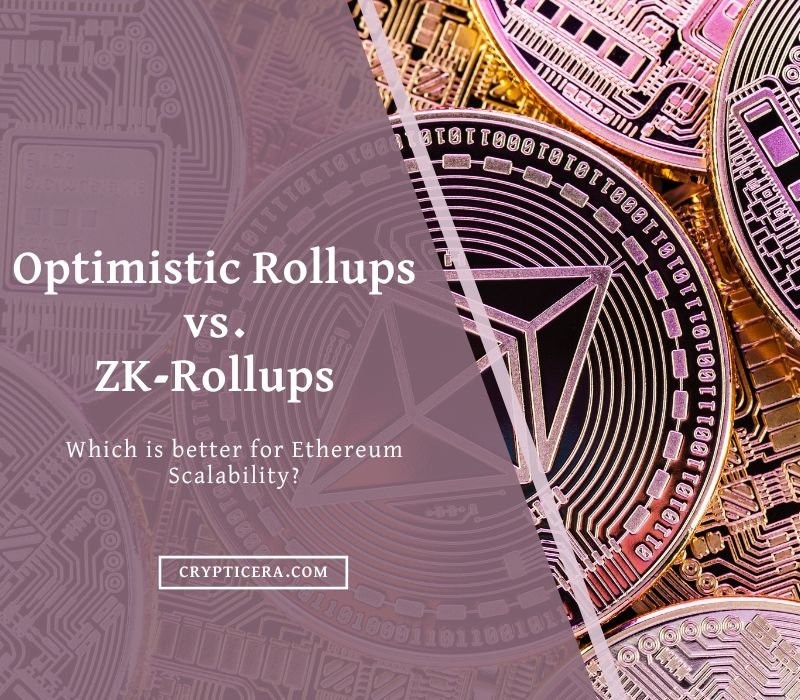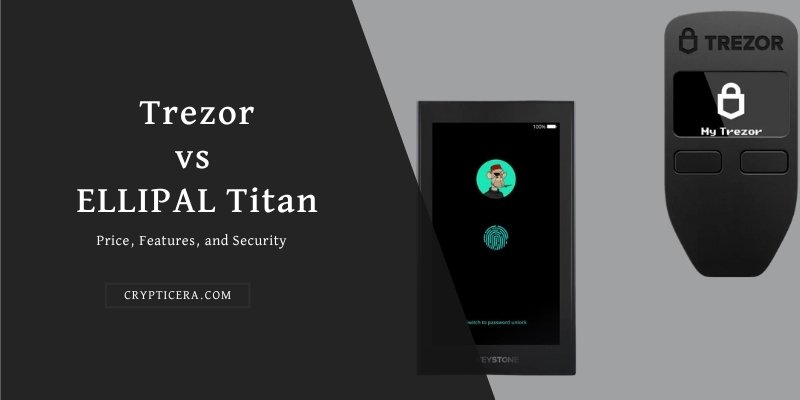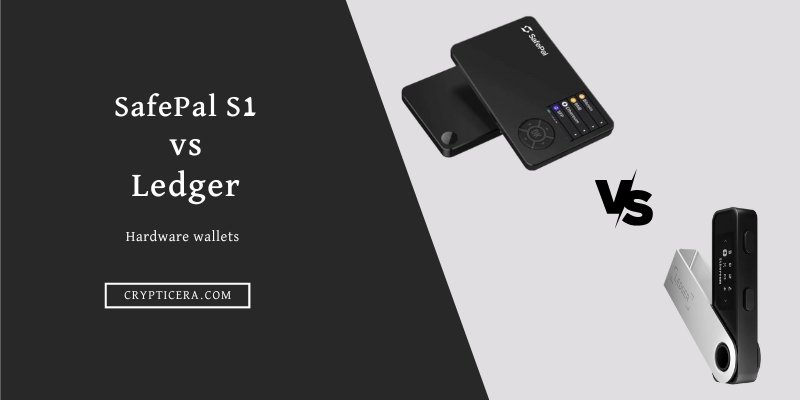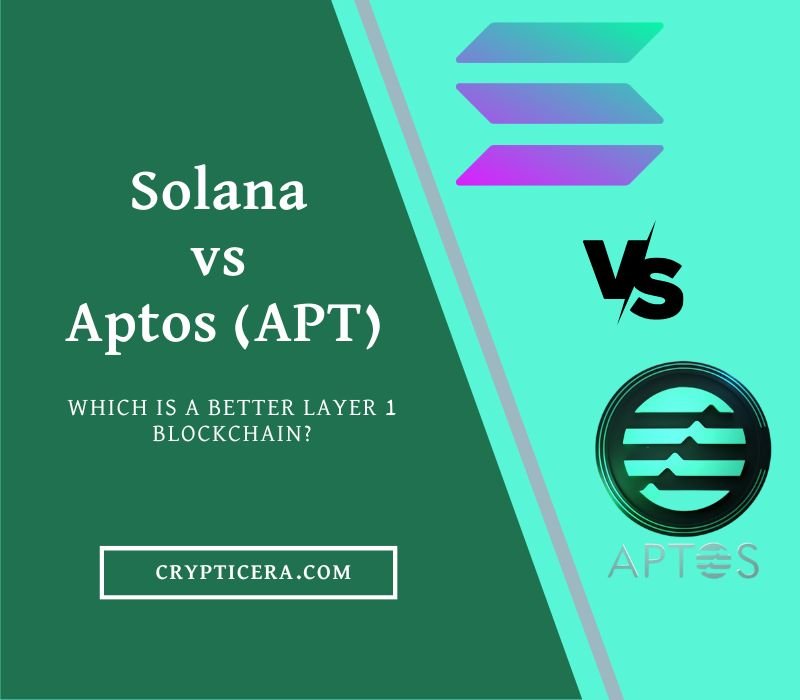Ethereum scalability has been a hot topic in the blockchain space, with various solutions vying for the top spot.
Two of the most prominent solutions are Optimistic Rollups and Zero-Knowledge (ZK) Rollups, both of which offer unique advantages as layer 2 scaling solutions.
Optimistic Rollups use a fraud-proof mechanism for security, while ZK-Rollups use zero-knowledge proofs for added security and privacy.
In this post, we’ll dive into the specifics of ‘Optimistic Rollups vs ZK-Rollups’ and how they work, exploring the trade-offs and benefits of each approach.
Optimistic Rollups vs ZK-Rollups: Key Differences
| Feature | Optimistic Rollups | ZK Rollups |
|---|---|---|
| Security | Lower security compared to ZK rollups due to the reliance on consensus mechanisms | Higher security as all transactions are verified through zero-knowledge proof technology |
| Scalability | Able to handle high transaction volumes | Able to handle high transaction volumes |
| Privacy | No privacy protection for transactions | Offers privacy protection by obscuring transaction details through zk-proofs |
| Complexity | Lower complexity compared to ZK rollups | Higher complexity due to the use of advanced cryptography |
| Cost | Lower cost as it does not require specialized hardware and is less computationally intensive | Higher cost due to the computational requirements of zero-knowledge proofs |
| Speed | Fast | fastest |
How Rollups Increase Ethereum Scalability?
Rollups are a layer 2 scaling solution for Ethereum. They help address the scalability challenges faced by the network. Rollups bundle multiple Ethereum transactions together and process them off-chain.
This results in faster and cheaper transactions compared to on-chain transactions. The processed transactions are then committed back to the Ethereum mainchain as a single transaction. This reduces the overall load on the network, enabling scalability.
The idea behind rollups is to process multiple transactions off-chain, committing them to the main chain in a more efficient manner. This increases scalability by processing more transactions per second.
There are two main types of rollups:
- Optimistic Rollups
- Zero-Knowledge (ZK) Rollups.
Both approaches have their own advantages and trade-offs. They are actively developed and adopted by the Ethereum community.
Optimistic Rollups
The key concept behind Optimistic Rollups is the use of a fraud-proof mechanism for security. This mechanism requires users to hold onto their original transaction data.
It can be used to challenge any invalid or malicious transactions processed off-chain, providing a secure and decentralized way to validate transactions. The fraud-proof mechanism ensures security without sacrificing speed or efficiency.
Multiple transactions can be processed in parallel off-chain, reducing the load on the Ethereum main chain. This enables it to process more transactions per second. Optimistic Rollups also offer faster and cheaper transactions compared to on-chain transactions.
ZK-Rollups
zk-rollups are a layer 2 scaling solution for Ethereum and other blockchain platforms. Transactions are processed and validated off-chain by a rollup operator.
Then, a small cryptographic proof is created and submitted to the main Ethereum chain. This enables users to transfer and store value off-chain while maintaining security guarantees.
The key innovation of zk-rollups is the use of zero-knowledge proofs. These proofs allow for the verifiability of computations without revealing underlying data. Rollup operators can process many transactions and only commit a compact proof to the Ethereum chain. This leads to significant scalability gains.
zk-rollups offer benefits such as lower transaction costs, increased transaction speed, and increased privacy for users. The underlying data is not visible on the main blockchain.
Optimistic Rollups vs ZK-Rollups
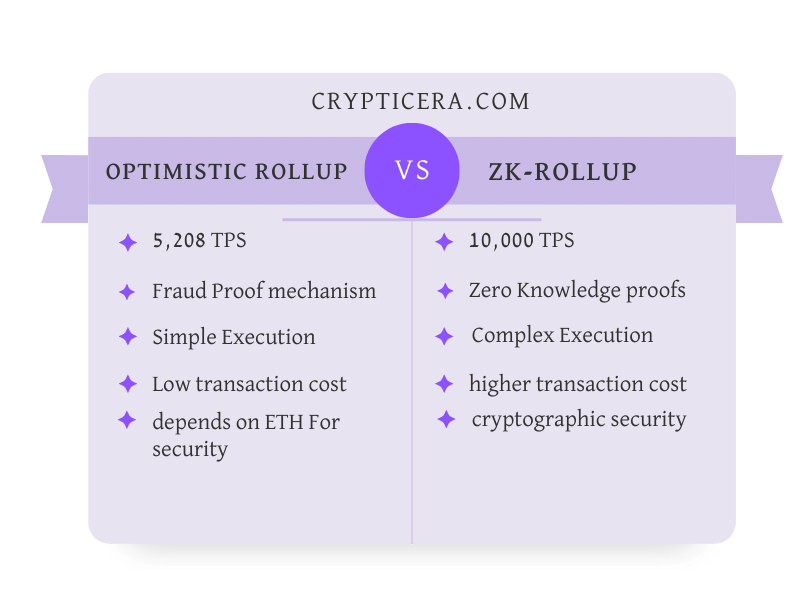
Transaction Speed
When withdrawing tokens from layer-2 transactions, the speed may vary based on the method used. Optimistic Rollups have a waiting period of one week before funds can be accessed. This is because there is a challenge period to conclude the legitimacy of the transaction.
In contrast, ZK-Rollups offer immediate withdrawal of funds. This is because they use validity proofs that guarantee the legitimacy of off-chain transactions. This results in no delays when accessing the funds.
Complexity
Optimistic rollups and ZK-rollups differ in terms of Smart Contracts programming complexity:
Optimistic rollups:
- Use an optimistic approach to confirm transactions off-chain, and then periodically batch and post them to the main Ethereum blockchain.
- Typically less complex to implement than ZK-rollups as they rely on Ethereum’s existing infrastructure.
- However, they still require a complex architecture and programming to manage the off-chain transactions, secure the Merkle trees, and handle dispute resolution.
ZK-Rollups:
- Use zk-SNARKs to prove the validity of off-chain transactions without revealing the transaction data.
- Have a higher level of programming complexity as they require a deep understanding of zero-knowledge proofs, complex cryptography, and specialized programming languages like CircuitJS.
- However, once built, ZK-rollups offer greater privacy, scalability, and lower transaction fees compared to Optimistic Rollups.
Security and Privacy
Optimistic Rollups offer limited privacy, as the data is stored on the Ethereum network and is visible to all users of the network. While the data is encrypted, it is still possible for malicious actors to access and use the data.
ZK-Rollups, on the other hand, offer a high level of privacy. The zero-knowledge proofs used in ZK-Rollups ensure that the data is confidential and not visible to anyone except for the parties involved in the transaction.
This makes ZK-Rollups ideal for sensitive transactions and for applications where privacy is a priority.
Transaction Cost
When comparing optimistic rollups and zero-knowledge rollups, transaction costs play a significant role. Optimistic rollups are typically more affordable as they require minimal data to be published on Ethereum and don’t need proof unless challenged. Furthermore, they can be made even cheaper with the help of EIP-4844 protocols.
In contrast, zero-knowledge rollups incur higher costs because they require computational proof and specialized hardware to generate them.
These factors make optimistic rollups a more cost-effective solution compared to zero-knowledge rollups.
Fraud-proof mechanism vs. Zero-Knowledge Proofs
Fraud-proof mechanisms and zero-knowledge proofs are two approaches for ensuring secure transactions on blockchain networks.
Fraud-proof mechanisms use consensus algorithms and cryptographic hashes to validate transactions and block data. They rely on multiple network participants agreeing on the current state of the blockchain to prevent manipulation by a single user.
Zero-knowledge proofs, on the other hand, provide verifiable transactions without revealing any sensitive information. This is achieved through mathematical algorithms that prove the authenticity of the transaction without disclosing any underlying data.
Thus, while fraud-proof mechanisms focus on maintaining consensus and secure data, zero-knowledge proofs prioritize privacy in transactions.
Examples of Optimistic Rollups
1. Optimism (OP)
Optimism is an Ethereum scaling solution that uses rollups. It increases the speed and reduces the cost of transactions. It uses a system of smart contracts and an off-chain database to manage transactions.
They are then batched together and sent to the Ethereum blockchain as a single transaction. This reduces the number of transactions processed by the Ethereum network, resulting in faster and cheaper transactions.
2. Arbitrum
Arbitrum is a Layer 2 scaling solution that also uses Optimistic rollups. It enhances the speed and security of Ethereum transactions. Transactions are moved off the Ethereum blockchain and onto its own network, where they are processed and validated.
This reduces the strain on the Ethereum network and improves the speed of transactions. It also provides an extra layer of security through the use of smart contracts.
Must Read: Optimism vs Arbitrum: Which is the better L2 Scalability Solution?
Examples of ZK-Rollups
1. Loopring (LRC)
Loopring is a decentralized exchange that uses a ZK-Rollup structure. It increases scalability and security for users who trade Ethereum-based assets. Loopring provides low fees, fast transaction times, and secure assets.
2. Polygon (MATIC)
Polygon is a Layer 2 scaling solution for Ethereum that will use zkEVM. It enables faster and cheaper transactions. Polygon offers services for developers and users, including a decentralized exchange, and a platform for decentralized applications.
Must Read: Top 5 ZK-Rollup Projects to Invest in 2023
Conclusion
In conclusion, both Optimistic Rollups and ZK-Rollups have their advantages for scaling blockchain technology.
Optimistic Rollups provide faster transactions and lower fees. On the other hand, ZK-Rollups offer stronger security guarantees.
The choice between these two solutions depends on the specific needs and priorities of a project.
The blockchain industry has a bright future, with continued advancements in scaling technologies driving change across various industries.
FAQs
What is the difference between ZK-rollups and optimistic rollups?
ZK rollups use zero-knowledge proofs to validate transactions off-chain, resulting in higher security and scalability. Optimistic rollups rely on on-chain disputes to resolve any issues, making them faster and less complex but less secure.
What is the downside of ZK rollups?
The downside of ZK rollups is that they require a higher level of technical complexity, making them harder to implement and potentially less accessible to non-technical users. They also require more computational resources and longer confirmation times compared to optimistic rollups.
Is Polygon Optimistic rollup or ZK-Rollup?
Polygon is a Layer 2 scaling solution that supports both optimistic rollups and ZK rollups.
How Zk & Optimistic Rollups Can Reduce Gas Fees?
ZK rollups and optimistic rollups can reduce gas fees by allowing for off-chain processing of transactions, which reduces the load on the Ethereum main chain. This results in lower fees and faster confirmation times, making them an attractive solution for scaling the Ethereum network.
